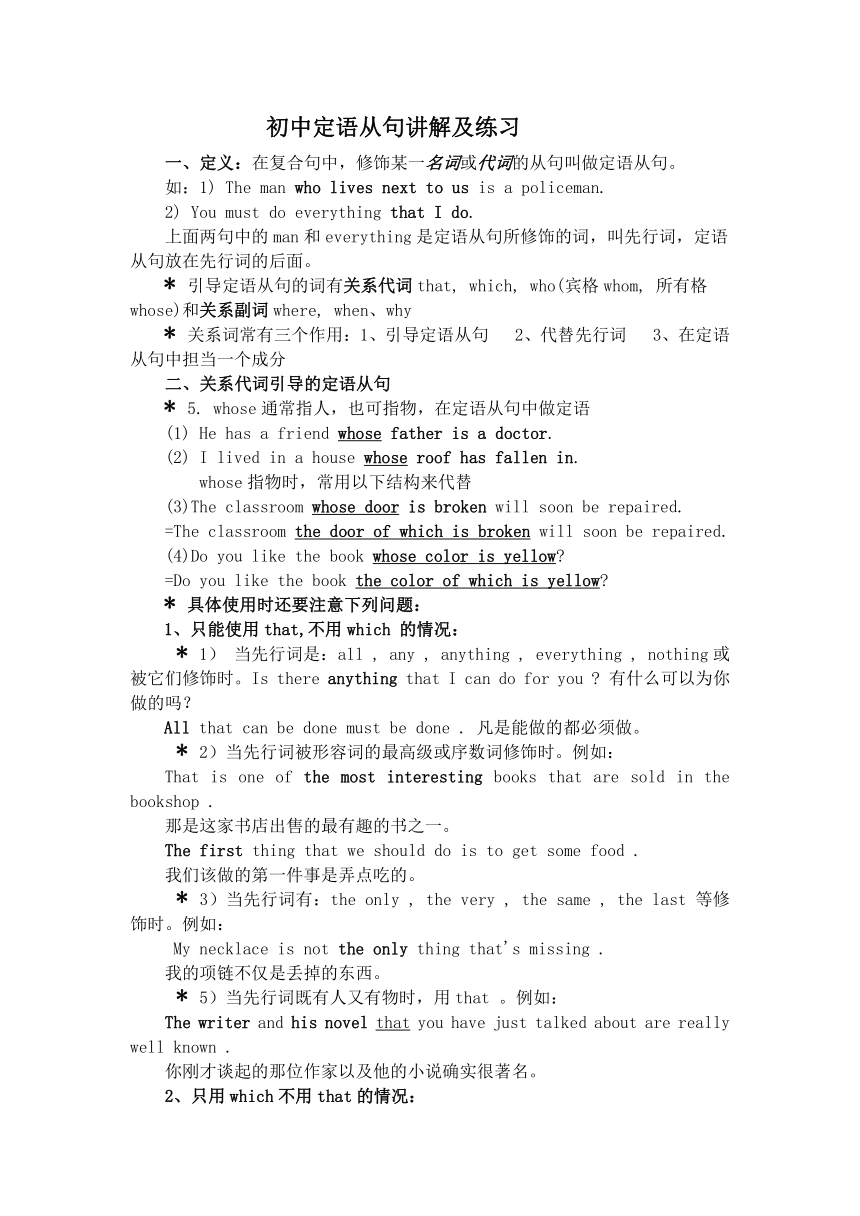2022年中考英语二轮复习——定语从句小结
文档属性
| 名称 | 2022年中考英语二轮复习——定语从句小结 |  | |
| 格式 | doc | ||
| 文件大小 | 25.0KB | ||
| 资源类型 | 教案 | ||
| 版本资源 | 通用版 | ||
| 科目 | 英语 | ||
| 更新时间 | 2022-03-10 14:55:47 | ||
图片预览


文档简介
初中定语从句讲解及练习
一、定义:在复合句中,修饰某一名词或代词的从句叫做定语从句。
如:1) The man who lives next to us is a policeman.
2) You must do everything that I do.
上面两句中的man和everything是定语从句所修饰的词,叫先行词,定语从句放在先行词的后面。
* 引导定语从句的词有关系代词that, which, who(宾格whom, 所有格whose)和关系副词where, when、why
* 关系词常有三个作用:1、引导定语从句 2、代替先行词 3、在定语从句中担当一个成分
二、关系代词引导的定语从句
* 5. whose通常指人,也可指物,在定语从句中做定语
(1) He has a friend whose father is a doctor.
(2) I lived in a house whose roof has fallen in.
whose指物时,常用以下结构来代替
(3)The classroom whose door is broken will soon be repaired.
=The classroom the door of which is broken will soon be repaired.
(4)Do you like the book whose color is yellow
=Do you like the book the color of which is yellow
* 具体使用时还要注意下列问题:
1、只能使用that,不用which 的情况:
* 1) 当先行词是:all , any , anything , everything , nothing或被它们修饰时。Is there anything that I can do for you 有什么可以为你做的吗?
All that can be done must be done . 凡是能做的都必须做。
* 2)当先行词被形容词的最高级或序数词修饰时。例如:
That is one of the most interesting books that are sold in the bookshop .
那是这家书店出售的最有趣的书之一。
The first thing that we should do is to get some food .
我们该做的第一件事是弄点吃的。
* 3)当先行词有:the only , the very , the same , the last 等修饰时。例如:
My necklace is not the only thing that's missing .
我的项链不仅是丢掉的东西。
* 5)当先行词既有人又有物时,用that 。例如:
The writer and his novel that you have just talked about are really well known .
你刚才谈起的那位作家以及他的小说确实很著名。
2、只用which不用that的情况:
* 1) 关系代词前有介词时;
e.g. This is the room in which Lu Xun lived.
* 2)非限定性定语从句中;作宾语用的关系代词也不能省略。
e.g. That necklace, which you gave me as a present, was lost yesterday.
He has a daughter, who works in a hospital.
* 3) 先行词本身是that时;
e.g. The clock is that which tells the time
非限定性定语从句的作用是对所修饰的成分作进一步说明,通常是引导词和先行词之间用逗号隔开,将从句拿掉后其他部分仍可成立 。
Charles Smith, who was my former teacher, retired last year. 查理史密斯去年退休了,他曾经是我的老师。
(非限)
There is somebody here who wants to speak to you这里有人要和你说话(限制性)
* 4) which还有一种特殊用法,它可以引导从句修饰前面的整个主句,代替主句所表示的整体概念或部分概念。在这种从句中,which可以作主语,也可以作宾语或表语,多数情况下意思是与and this 相似,并可以指人。
He did very well in the competition, which made his parents very happy.
* 关系代词 whom, which 在定语从句中作介词宾语时,可以和介词一起放于先行词与定语从句之间,有时为了关系紧凑也可以将 whom 与 which 与先行词紧挨着书写,而将介词置于定语从句的后面,
That was the room in which we had lived for ten years.
= That was the room which we had lived in for ten years.
* 像listen to, look at, take care of等固定短语动词,在定语从句中一般不宜将介词与动词分开。例如:This is the boy whom she has taken care of.
三、关系副词引导的定语从句
* 1、when:当主句中的先行词(即主句中被后面定语从句修饰的词)是表示时间意义的名词时,它只能作定语从句的时间状语,放在定语从句句首。如果定语从句的引导词是作该定语从句的主语或宾语,则要改用关系代词that或which来引导。例如:
I’ll never forget the time when we worked on the farm.
He arrived in Beijing on the day when I left.
The days when we used foreign oil are gone. 我们用洋油的日子一去不复返了。
I'll never forget the day when I was born. (=I'll never forget my birthday.) 我永远不会忘记我出生的日子。
It happened in November when the weather was wet and cold.
这事发生在天气又湿又冷的十一月。
The day (that) I always remember in all my life is my birthday. 我一生中最难忘的日子是我的生日。(that作定语从句"that I always remember in all my life"的宾语,that可以省略)
* 2、where:当主句中的先行词是表示地点意义的名词时,它只能作其所在的定语从句的地点状语,放在定语从句的句首。如果定语从句的引导词作该定语从句的主语或宾语时,也要改用关系代词that或which来引导。例如:
The factory where his father works is in the east of the city
This is the room where (=in which) I lived last year. 这就是我去年住过的房间。
Is this the classroom where(=in which) the old worker is going to make/give us a report 这就是那位老工人要给我们做报告的教室吗?
Let's look for a place where we can swim. 咱们找一个可以游泳的地方吧。
The building that is being built over there will be a new hospital. 正在那边建的楼房将是一家新医院。(引导词that作定语从句"that is being built over there"的主语)
That is the factory (that) they visited last month. 那就是他们上个月参观过
的工厂。(引导词that作定语从句"(that) they visited last month"的宾语,that可以省略)
* 注意:不要以为在时间名词后就一定用关系副词when,在地点名词后就一定用关系副词 where,在表示原因的the reason后就一定用关系副词why。到底选用关系副词还是关系代词,关键是看它们在从句中是用作状语(用关系副词)还是用作主语或宾语(用关系代词)。
如:Don’t forget the time (that) I’ve told you. 不要忘记我告诉你的时间。(that用作told的宾语)
I’ll never forget the days when I worked with you. 我永远不会忘记我与你共事的日子。(when用作状语)
He works in a factory that /which makes radio parts. 他在一家制造无线电零件的工厂工作。(that/ which 在从句中用作主语,且不能省略)
He works in the factory where his father worked. 他在他父亲工作过的那家工厂工作。(where作状语)
That’s the reason (that /which ) he explained to us. 那就是他向我们解释的理由。(that或which在从句中用作explained的宾语)
That’s the reason why she left home. 那就是她离家出走的原因。(why在从句中作状语)
* 英语中的关系副词主要是 when, where, why三个,不要想当然地将how用作关系副词修饰the way。
如不说 This is the way how he spoke,
可改为 This is how he spoke(how引导的是表语从句),
当然也可说成 This is the way (that/ in which) he spoke.(其中的that/ in which可省略)
* 另外,when和where可引导限制性和非限制性定语从句,而why则只用于引导限制性定语从句,不用于引导非限制性定语从句。
Sunday is a holiday , when people do not go to work.
星期天是假日,(这天)人们不上班。
He took us into the classroom , where there were only a few students.
他把我们带进教室,那儿只有少数几个学生。
* 在定语从句的使用中,one of后面的名词是复数,这个复数名词制约后面的定语从句的谓语动词,用复数; 而在one of 前面有the或 the only时,后面引导的定语从句中的谓语动词则用单数形式。
He is the only one of the students who is elected
Jasper is one of those people who know about the accident .
一、定义:在复合句中,修饰某一名词或代词的从句叫做定语从句。
如:1) The man who lives next to us is a policeman.
2) You must do everything that I do.
上面两句中的man和everything是定语从句所修饰的词,叫先行词,定语从句放在先行词的后面。
* 引导定语从句的词有关系代词that, which, who(宾格whom, 所有格whose)和关系副词where, when、why
* 关系词常有三个作用:1、引导定语从句 2、代替先行词 3、在定语从句中担当一个成分
二、关系代词引导的定语从句
* 5. whose通常指人,也可指物,在定语从句中做定语
(1) He has a friend whose father is a doctor.
(2) I lived in a house whose roof has fallen in.
whose指物时,常用以下结构来代替
(3)The classroom whose door is broken will soon be repaired.
=The classroom the door of which is broken will soon be repaired.
(4)Do you like the book whose color is yellow
=Do you like the book the color of which is yellow
* 具体使用时还要注意下列问题:
1、只能使用that,不用which 的情况:
* 1) 当先行词是:all , any , anything , everything , nothing或被它们修饰时。Is there anything that I can do for you 有什么可以为你做的吗?
All that can be done must be done . 凡是能做的都必须做。
* 2)当先行词被形容词的最高级或序数词修饰时。例如:
That is one of the most interesting books that are sold in the bookshop .
那是这家书店出售的最有趣的书之一。
The first thing that we should do is to get some food .
我们该做的第一件事是弄点吃的。
* 3)当先行词有:the only , the very , the same , the last 等修饰时。例如:
My necklace is not the only thing that's missing .
我的项链不仅是丢掉的东西。
* 5)当先行词既有人又有物时,用that 。例如:
The writer and his novel that you have just talked about are really well known .
你刚才谈起的那位作家以及他的小说确实很著名。
2、只用which不用that的情况:
* 1) 关系代词前有介词时;
e.g. This is the room in which Lu Xun lived.
* 2)非限定性定语从句中;作宾语用的关系代词也不能省略。
e.g. That necklace, which you gave me as a present, was lost yesterday.
He has a daughter, who works in a hospital.
* 3) 先行词本身是that时;
e.g. The clock is that which tells the time
非限定性定语从句的作用是对所修饰的成分作进一步说明,通常是引导词和先行词之间用逗号隔开,将从句拿掉后其他部分仍可成立 。
Charles Smith, who was my former teacher, retired last year. 查理史密斯去年退休了,他曾经是我的老师。
(非限)
There is somebody here who wants to speak to you这里有人要和你说话(限制性)
* 4) which还有一种特殊用法,它可以引导从句修饰前面的整个主句,代替主句所表示的整体概念或部分概念。在这种从句中,which可以作主语,也可以作宾语或表语,多数情况下意思是与and this 相似,并可以指人。
He did very well in the competition, which made his parents very happy.
* 关系代词 whom, which 在定语从句中作介词宾语时,可以和介词一起放于先行词与定语从句之间,有时为了关系紧凑也可以将 whom 与 which 与先行词紧挨着书写,而将介词置于定语从句的后面,
That was the room in which we had lived for ten years.
= That was the room which we had lived in for ten years.
* 像listen to, look at, take care of等固定短语动词,在定语从句中一般不宜将介词与动词分开。例如:This is the boy whom she has taken care of.
三、关系副词引导的定语从句
* 1、when:当主句中的先行词(即主句中被后面定语从句修饰的词)是表示时间意义的名词时,它只能作定语从句的时间状语,放在定语从句句首。如果定语从句的引导词是作该定语从句的主语或宾语,则要改用关系代词that或which来引导。例如:
I’ll never forget the time when we worked on the farm.
He arrived in Beijing on the day when I left.
The days when we used foreign oil are gone. 我们用洋油的日子一去不复返了。
I'll never forget the day when I was born. (=I'll never forget my birthday.) 我永远不会忘记我出生的日子。
It happened in November when the weather was wet and cold.
这事发生在天气又湿又冷的十一月。
The day (that) I always remember in all my life is my birthday. 我一生中最难忘的日子是我的生日。(that作定语从句"that I always remember in all my life"的宾语,that可以省略)
* 2、where:当主句中的先行词是表示地点意义的名词时,它只能作其所在的定语从句的地点状语,放在定语从句的句首。如果定语从句的引导词作该定语从句的主语或宾语时,也要改用关系代词that或which来引导。例如:
The factory where his father works is in the east of the city
This is the room where (=in which) I lived last year. 这就是我去年住过的房间。
Is this the classroom where(=in which) the old worker is going to make/give us a report 这就是那位老工人要给我们做报告的教室吗?
Let's look for a place where we can swim. 咱们找一个可以游泳的地方吧。
The building that is being built over there will be a new hospital. 正在那边建的楼房将是一家新医院。(引导词that作定语从句"that is being built over there"的主语)
That is the factory (that) they visited last month. 那就是他们上个月参观过
的工厂。(引导词that作定语从句"(that) they visited last month"的宾语,that可以省略)
* 注意:不要以为在时间名词后就一定用关系副词when,在地点名词后就一定用关系副词 where,在表示原因的the reason后就一定用关系副词why。到底选用关系副词还是关系代词,关键是看它们在从句中是用作状语(用关系副词)还是用作主语或宾语(用关系代词)。
如:Don’t forget the time (that) I’ve told you. 不要忘记我告诉你的时间。(that用作told的宾语)
I’ll never forget the days when I worked with you. 我永远不会忘记我与你共事的日子。(when用作状语)
He works in a factory that /which makes radio parts. 他在一家制造无线电零件的工厂工作。(that/ which 在从句中用作主语,且不能省略)
He works in the factory where his father worked. 他在他父亲工作过的那家工厂工作。(where作状语)
That’s the reason (that /which ) he explained to us. 那就是他向我们解释的理由。(that或which在从句中用作explained的宾语)
That’s the reason why she left home. 那就是她离家出走的原因。(why在从句中作状语)
* 英语中的关系副词主要是 when, where, why三个,不要想当然地将how用作关系副词修饰the way。
如不说 This is the way how he spoke,
可改为 This is how he spoke(how引导的是表语从句),
当然也可说成 This is the way (that/ in which) he spoke.(其中的that/ in which可省略)
* 另外,when和where可引导限制性和非限制性定语从句,而why则只用于引导限制性定语从句,不用于引导非限制性定语从句。
Sunday is a holiday , when people do not go to work.
星期天是假日,(这天)人们不上班。
He took us into the classroom , where there were only a few students.
他把我们带进教室,那儿只有少数几个学生。
* 在定语从句的使用中,one of后面的名词是复数,这个复数名词制约后面的定语从句的谓语动词,用复数; 而在one of 前面有the或 the only时,后面引导的定语从句中的谓语动词则用单数形式。
He is the only one of the students who is elected
Jasper is one of those people who know about the accident .
同课章节目录
- 词法
- 名词
- 动词和动词短语
- 动词语态
- 动词时态
- 助动词和情态动词
- 非谓语动词
- 冠词
- 代词
- 数词和量词
- 形容词副词及其比较等级
- 介词和介词短语
- 连词和感叹词
- 构词法
- 相似、相近词比较
- 句法
- 陈述句
- 一般疑问句和否定疑问句
- 特殊疑问句及选择疑问句
- 反意疑问句
- 存在句(There be句型)
- 宾语从句
- 定语从句
- 状语从句
- 主谓一致问题
- 简单句
- 并列句
- 复合句
- 主谓一致
- 主、表语从句
- 名词性从句
- 直接引语和间接引语
- 虚拟语气
- 感叹句
- 强调句
- 倒装句
- 祈使句
- 句子的成分
- 句子的分类
- 题型专区
- 单项选择部分
- 易错题
- 完形填空
- 阅读理解
- 词汇练习
- 听说训练
- 句型转换
- 补全对话
- 短文改错
- 翻译
- 书面表达
- 任务型阅读
- 语法填空
- 其他资料
